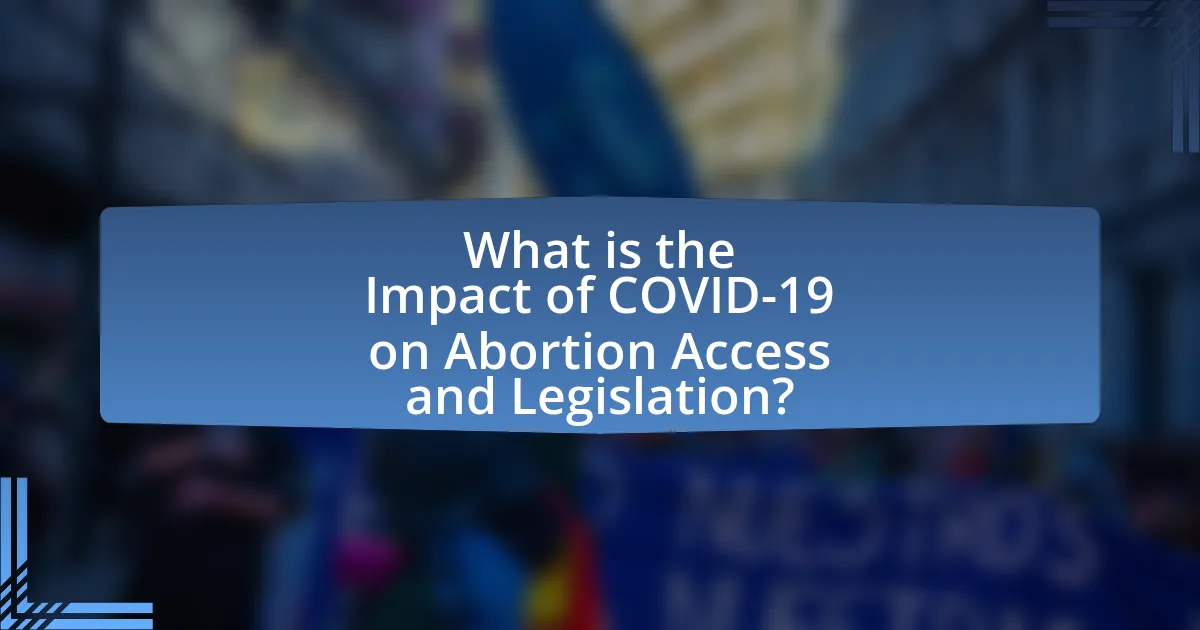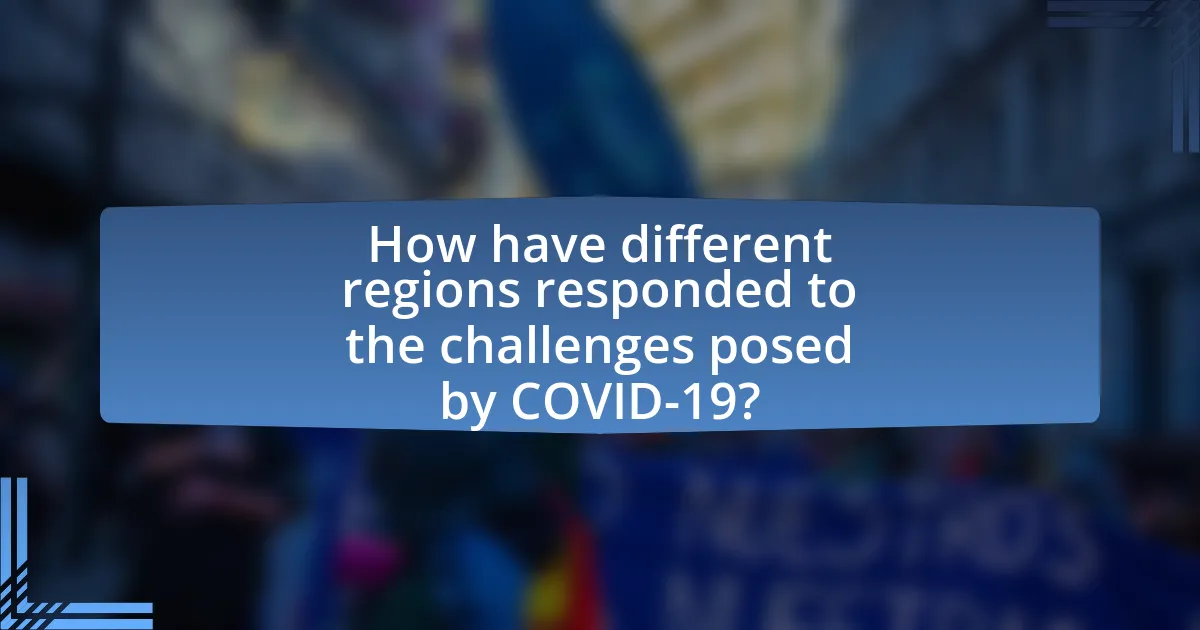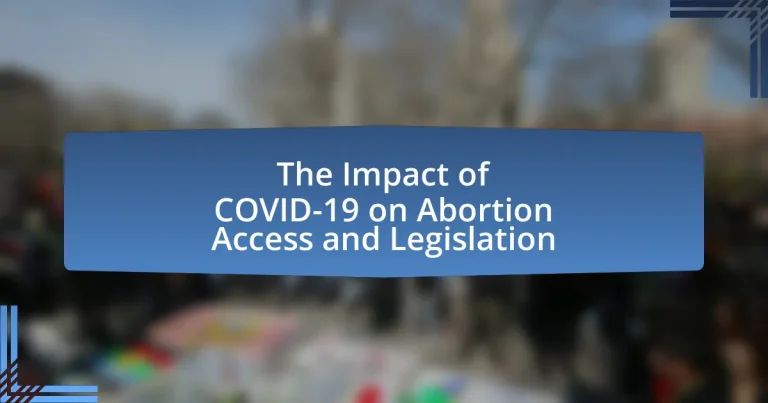The article examines the significant impact of COVID-19 on abortion access and legislation, highlighting increased barriers to services and changes in legal frameworks across various states. It details how the pandemic led to temporary bans on elective procedures, including abortions, and the subsequent rise in state-level restrictions, with 19 states enacting 66 new laws in 2020. The article also discusses the adaptation of healthcare facilities through telehealth services and the legislative shifts that allowed for remote consultations and medication abortions. Furthermore, it addresses the implications of these changes on women’s health, the regional disparities in access, and the evolving role of advocacy groups in response to the challenges posed by the pandemic.

What is the Impact of COVID-19 on Abortion Access and Legislation?
The impact of COVID-19 on abortion access and legislation has been significant, resulting in increased barriers to services and changes in legal frameworks. During the pandemic, many states implemented restrictions that limited access to abortion services, citing public health concerns. For example, in 2020, several states temporarily banned elective procedures, which included abortions, leading to delays and increased travel distances for patients seeking care. Additionally, some jurisdictions expanded telehealth services for medication abortions, which provided a new avenue for access amidst physical distancing measures. However, these changes were not uniform; some states enacted more restrictive laws, while others sought to protect access. Data from the Guttmacher Institute indicated that 2020 saw a rise in state-level abortion restrictions, with 19 states enacting 66 new abortion restrictions, reflecting a complex landscape influenced by the pandemic.
How has COVID-19 affected access to abortion services?
COVID-19 has significantly restricted access to abortion services due to lockdown measures and healthcare system disruptions. Many clinics reduced their services or closed temporarily, leading to increased travel distances for patients seeking care. According to a study published in the journal “Health Affairs,” 40% of abortion providers reported a decrease in patient volume during the pandemic, while 30% faced challenges in obtaining necessary supplies. Additionally, some states implemented stricter regulations on telehealth services, further complicating access to medication abortions.
What barriers to access have emerged during the pandemic?
During the pandemic, significant barriers to abortion access emerged, including increased restrictions on services, limited availability of healthcare providers, and logistical challenges such as transportation and clinic closures. For instance, many states implemented laws that required in-person visits for medication abortions, despite the availability of telehealth options, which restricted access for individuals in remote areas. Additionally, the COVID-19 pandemic led to the temporary closure of clinics and reduced operating hours, further limiting access to essential reproductive healthcare. According to the Guttmacher Institute, 30 states enacted laws that could restrict abortion access during the pandemic, highlighting the legislative challenges faced by individuals seeking these services.
How have healthcare facilities adapted to provide abortion services?
Healthcare facilities have adapted to provide abortion services by implementing telehealth options, expanding medication abortion access, and enhancing safety protocols. During the COVID-19 pandemic, many facilities transitioned to telehealth consultations, allowing patients to receive medical advice and prescriptions remotely, which reduced in-person visits. Additionally, the use of medication abortion has increased, with some states allowing patients to obtain abortion pills through mail, thereby minimizing exposure risks. Enhanced safety protocols, including social distancing measures and increased sanitation, have also been established to protect both patients and healthcare workers. These adaptations have been crucial in maintaining access to abortion services amid the challenges posed by the pandemic.
What changes in legislation have occurred due to COVID-19?
COVID-19 has led to significant changes in legislation regarding abortion access, primarily through the expansion of telehealth services and the easing of restrictions on medication abortion. Many states temporarily allowed telemedicine consultations for abortion services, enabling patients to receive prescriptions remotely, which was crucial during lockdowns. Additionally, some jurisdictions relaxed regulations surrounding the distribution of abortion pills, allowing them to be mailed directly to patients, thereby increasing access during the pandemic. These legislative changes were implemented to ensure continued reproductive healthcare access amidst public health concerns, reflecting a shift in policy to adapt to the challenges posed by COVID-19.
Which states have enacted new abortion laws during the pandemic?
Several states have enacted new abortion laws during the pandemic, including Texas, Florida, and Arkansas. Texas implemented a law in September 2021 that bans most abortions after six weeks of pregnancy, significantly restricting access. Florida passed a law in 2020 that requires a 24-hour waiting period before an abortion, while Arkansas enacted a near-total abortion ban in 2021, making exceptions only for medical emergencies. These legislative changes reflect a broader trend of states pursuing more restrictive abortion policies during the COVID-19 pandemic.
How have existing laws been challenged or upheld in response to COVID-19?
Existing laws regarding abortion access have been both challenged and upheld in response to COVID-19. Numerous states attempted to classify abortion services as non-essential, leading to legal challenges from reproductive rights organizations, which argued that such actions violated constitutional rights and access to healthcare. For instance, in Texas, a temporary ban on abortions was met with a lawsuit from the Center for Reproductive Rights, resulting in a federal court ruling that allowed abortions to continue during the pandemic. Conversely, some states upheld restrictions, citing public health concerns, which led to ongoing litigation and debates over the balance between health regulations and reproductive rights. These legal battles reflect the broader implications of COVID-19 on existing laws and the ongoing struggle for abortion access amidst public health crises.
What are the implications of these changes for women’s health?
The implications of changes in abortion access and legislation during COVID-19 for women’s health are significant, leading to increased health risks and adverse outcomes. Restricted access to abortion services can result in delayed procedures, forcing women to carry unwanted pregnancies to term, which can lead to physical and mental health complications. Research indicates that women denied abortions are more likely to experience economic hardship and mental health issues, as highlighted in a study published in the American Journal of Public Health, which found that 95% of women who sought abortions reported that it was the right decision for them. Additionally, the pandemic has exacerbated barriers such as transportation and healthcare access, further compromising women’s health outcomes.
How does restricted access to abortion services impact women’s health outcomes?
Restricted access to abortion services negatively impacts women’s health outcomes by increasing the risk of unsafe procedures and adverse mental health effects. When women are unable to obtain safe and legal abortions, they may resort to unsafe methods, leading to complications such as infections, hemorrhage, or even death. According to the World Health Organization, unsafe abortions account for approximately 13% of maternal deaths globally. Additionally, restricted access can exacerbate mental health issues, as women may experience increased anxiety, depression, and stress due to unwanted pregnancies and the inability to make autonomous choices about their reproductive health. Studies have shown that women denied abortions are more likely to experience long-term psychological distress compared to those who receive the care they seek.
What role does telemedicine play in abortion access during the pandemic?
Telemedicine significantly expanded abortion access during the pandemic by allowing patients to consult healthcare providers remotely. This shift enabled individuals to receive medical abortion services without needing to visit clinics in person, which was crucial during lockdowns and social distancing measures. According to a study published in the journal “Obstetrics & Gynecology,” telemedicine consultations increased by over 200% for abortion services during the pandemic, demonstrating its effectiveness in maintaining access to reproductive healthcare.

How have different regions responded to the challenges posed by COVID-19?
Different regions have responded to the challenges posed by COVID-19 through varying measures that impacted abortion access and legislation. For instance, in the United States, several states enacted restrictions on abortion services citing public health concerns, while others classified abortion as an essential service, ensuring continued access. In contrast, countries like Canada expanded telehealth services, allowing for medical abortions to be prescribed remotely, thereby increasing accessibility during lockdowns. Additionally, some European nations implemented temporary measures to facilitate access, such as allowing home use of abortion pills. These responses reflect a diverse approach to balancing public health priorities with reproductive rights during the pandemic.
What regional differences exist in abortion access during the pandemic?
During the pandemic, significant regional differences in abortion access emerged across the United States. States with restrictive abortion laws, particularly in the South and Midwest, faced greater barriers, including clinic closures and limited telehealth options, compared to more liberal states on the West Coast and Northeast, where access remained relatively stable. For instance, a study by the Guttmacher Institute reported that 15 states enacted laws to restrict abortion access during the pandemic, while states like California and New York expanded access through telemedicine and maintained clinic operations. These disparities highlight the uneven landscape of reproductive healthcare during COVID-19, influenced by local legislation and healthcare infrastructure.
How have urban and rural areas been affected differently?
Urban and rural areas have been affected differently in terms of abortion access during the COVID-19 pandemic, with urban areas generally experiencing more accessible services compared to rural areas. Urban regions often have multiple healthcare facilities and providers, allowing for greater availability of abortion services, while rural areas face significant barriers such as fewer clinics, longer travel distances, and limited healthcare resources. For instance, a study by the Guttmacher Institute in 2020 highlighted that 90% of U.S. counties without an abortion provider are rural, illustrating the stark contrast in access between these areas. Additionally, the pandemic exacerbated existing disparities, as rural residents encountered increased challenges in obtaining necessary healthcare due to transportation issues and clinic closures.
What role do local health departments play in regulating abortion access?
Local health departments play a critical role in regulating abortion access by enforcing state laws, overseeing clinic operations, and ensuring compliance with health and safety standards. They are responsible for issuing licenses to abortion providers, conducting inspections, and monitoring the quality of care provided. For instance, during the COVID-19 pandemic, many local health departments adapted their regulations to address public health concerns, which impacted access to abortion services. This included implementing safety protocols and, in some cases, restricting access based on health guidelines. Their regulatory actions directly influence the availability and accessibility of abortion services within their jurisdictions.
How have advocacy groups responded to changes in abortion access?
Advocacy groups have actively mobilized to respond to changes in abortion access, particularly in the context of COVID-19. These organizations have implemented strategies such as increasing telehealth services for consultations and medication abortions, which became crucial during lockdowns. For instance, the Guttmacher Institute reported that telehealth services expanded significantly, allowing patients to access care while minimizing exposure risks. Additionally, advocacy groups have engaged in legal battles to challenge restrictive state laws that emerged during the pandemic, emphasizing the importance of maintaining reproductive rights. The National Abortion Federation noted a rise in litigation efforts aimed at protecting access to abortion services in various states, highlighting the ongoing commitment of these groups to safeguard reproductive health amid evolving legislative landscapes.
What strategies have been employed by organizations to support access?
Organizations have employed telehealth services, advocacy for policy changes, and community outreach programs to support access to abortion during the COVID-19 pandemic. Telehealth services have enabled patients to consult with healthcare providers remotely, facilitating access to medication abortion and reducing the need for in-person visits. Advocacy efforts have focused on pushing for legislative changes that protect and expand access to abortion services, such as removing unnecessary restrictions and ensuring that abortion remains an essential service during health crises. Community outreach programs have aimed to educate individuals about available resources and support systems, ensuring that marginalized populations receive the necessary information and assistance. These strategies have been crucial in maintaining access to abortion services amid the challenges posed by the pandemic.
How have public awareness campaigns evolved during COVID-19?
Public awareness campaigns during COVID-19 have evolved to prioritize digital platforms and targeted messaging to address health concerns and misinformation. Initially, campaigns focused on general health guidelines, but they quickly adapted to include specific issues such as reproductive health and access to abortion services, reflecting the pandemic’s impact on healthcare access. For instance, organizations like Planned Parenthood shifted their outreach to online resources and telehealth services, ensuring that individuals could still receive necessary information and care despite physical distancing measures. This evolution was driven by the need to reach diverse populations effectively, utilizing social media and mobile apps to disseminate information rapidly and engage with communities directly.

What are the long-term effects of COVID-19 on abortion access and legislation?
The long-term effects of COVID-19 on abortion access and legislation include increased restrictions and challenges to access in various regions. During the pandemic, many states enacted temporary measures that limited abortion services, which have led to permanent legislative changes in some areas. For instance, a study by the Guttmacher Institute found that 19 states enacted new abortion restrictions during the pandemic, reflecting a trend toward more stringent laws. Additionally, the public health crisis has shifted the focus of healthcare resources, often prioritizing other medical services over reproductive health, which could further limit access to abortion services in the future.
How might the pandemic reshape future abortion policies?
The pandemic may reshape future abortion policies by accelerating the adoption of telehealth services for medication abortions. Research indicates that during the COVID-19 pandemic, many jurisdictions relaxed restrictions on telehealth, allowing patients to obtain abortion pills remotely, which increased access for individuals in areas with limited healthcare facilities. A study published in the journal “Health Affairs” found that telehealth services for abortion increased significantly during the pandemic, suggesting a potential long-term shift in how abortion services are delivered. This shift could lead to more flexible policies that prioritize patient access and safety, reflecting the lessons learned during the health crisis.
What trends in legislation can be anticipated post-pandemic?
Post-pandemic, trends in legislation regarding abortion access are likely to include increased state-level restrictions and a push for more comprehensive reproductive health policies. Following the Supreme Court’s decision in Dobbs v. Jackson Women’s Health Organization, many states have enacted or are considering laws that further limit abortion access, reflecting a trend towards more conservative legislation. Additionally, there is a growing movement in some states to enhance protections for reproductive rights, as seen in states like California and New York, which are implementing measures to safeguard access to abortion services. This dual trend of restriction in some areas and protection in others indicates a polarized legislative landscape influenced by the pandemic’s socio-political climate.
How might public opinion on abortion access change as a result of COVID-19?
Public opinion on abortion access may shift towards greater support due to the challenges faced during the COVID-19 pandemic. The pandemic highlighted healthcare disparities and access issues, leading many to recognize the importance of reproductive health services. For instance, a survey conducted by the Guttmacher Institute in 2020 indicated that 77% of respondents believed that abortion should remain accessible during public health emergencies. Additionally, restrictions on in-person healthcare during lockdowns prompted discussions about the necessity of telehealth options for abortion services, further influencing public sentiment towards more supportive policies.
What lessons can be learned from the pandemic regarding reproductive health?
The pandemic highlighted the critical need for accessible reproductive health services, particularly in times of crisis. During COVID-19, many individuals faced barriers to abortion access due to clinic closures and restrictions on services, which underscored the importance of telehealth options and medication abortion. Research from the Guttmacher Institute indicated that states with fewer restrictions on telehealth saw increased access to reproductive health services, demonstrating that flexibility in service delivery can mitigate access issues during emergencies. Additionally, the pandemic revealed disparities in reproductive health access, particularly for marginalized communities, emphasizing the need for equitable healthcare policies that prioritize reproductive rights.
How can healthcare systems better prepare for future public health crises?
Healthcare systems can better prepare for future public health crises by implementing robust surveillance systems and enhancing inter-agency collaboration. Effective surveillance allows for early detection of outbreaks, as evidenced by the World Health Organization’s emphasis on real-time data sharing during the COVID-19 pandemic, which facilitated timely responses. Additionally, fostering collaboration among public health agencies, healthcare providers, and community organizations can streamline resource allocation and improve communication, as demonstrated by successful partnerships during the Ebola outbreak. These strategies ensure a proactive approach to managing public health emergencies.
What best practices can be implemented to ensure continued access to abortion services?
To ensure continued access to abortion services, implementing telehealth options is essential. Telehealth allows patients to consult with healthcare providers remotely, which can increase access, especially during public health emergencies like COVID-19. A study published in the American Journal of Public Health found that telehealth services significantly improved access to reproductive health care during the pandemic, demonstrating that remote consultations can effectively facilitate medical abortions and follow-up care. Additionally, advocating for policy changes that protect and expand abortion rights is crucial, as evidenced by the Guttmacher Institute’s research indicating that states with supportive policies have better access to abortion services.


